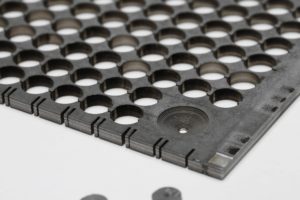This website uses cookies so that we can provide you with the best user experience possible. Cookie information is stored in your browser and performs functions such as recognising you when you return to our website and helping our team to understand which sections of the website you find most interesting and useful.
Photochemical Etching: A Cost-Effective Alternative for Mass Producing Fuel Cell Stacks
As demand for zero-emission transportation continues to rise, the global fuel cell market is predicted to hit $201 billion by 2025. In response, several manufacturing companies are teaming up to mass produce hydrogen fuel cells, fuel cell stacks, and the infrastructure to support material handling equipment (MHE) and fuel cell electric vehicle (FCEV) fleets.
Current manufacturing processes for fuel cell stacks and fuel plates can be slow, expensive, and labor intensive with low automation levels. Fotofab proposes a different solution for fuel call plates called photochemical machining or etching. The fabrication process has been around for over 50 years and is quicker, more cost efficient, and scalable.
Fuel Cell Technology
Fuel cells are like batteries, but they do not run down or need to be recharged. Using the chemical energy of hydrogen, they efficiently produce electricity and heat as long as fuel is supplied.
A single fuel cell produces less than 1.16 volts of electricity, but the amount of power depends on its type, cell size, temperature at which it operates, and the pressure at which the gases are supplied to the cell. A fuel cell stack consists of several individual cells combined into a series, which increases the amount of electricity generated.
Fuel cells hardware involves bipolar plates and gaskets. The plates have several functions:
- They channel hydrogen and oxygen to the electrodes within the fuel cell.
- They channel water and heat away from the fuel cell.
- They conduct electrons from the anode to the electrical circuit and from the electrical circuit, back to the cathode.
- They provide physical strength between each fuel stack.

At the surface of each plate are a set of intricate channels that circulate a liquid or gas. Traditionally, fuel cell plates have been manufactured from non-metallic metals like graphite, with CNC machines, hydroforming, and stamping. Graphite is an expensive, high permeability material that is less than ideal for mass manufacturing applications. While it is lighter than any metal and not prone to corrosion, it is very brittle, porous, and features lower electrical and thermal conductivities.
Fotofab offers photochemical etching as a cost-efficient alternative to traditional processes like CNC machining, stamping, and hydroforming which produce stresses and burrs and compromise the flatness (planarity) of the sheet metal. The etching process is also quicker and less costly for R&D.
Advantages of Photochemically Etched Fuel Cells
Photochemically etched fuel cell plates offer greater design flexibility for fuel cell manufacturers and OEMs. The process uses digital tooling to optimize design at minimal costs and offers lead times measured in days not months. Other advantages include:
- Seamlessly increase from prototype volumes to high volume production.
- Unlimited part complexity.
- Burr-free and stress-free components (important for fuel cell plates where imperfections can compromise stack bonding).
- Repeatable accuracy and tight tolerances.
Additionally, photochemical etching does not affect a metal’s temper or properties, and it is appropriate for all grades of steel.
During production, chemical etching removes metals on both sides of the plate simultaneously. This versatility enables design engineers to create channels of various sizes, shapes, and complexities without incurring additional tooling costs. The process is also suitable for creating micro- and macro-channels needed in miniaturized fuel cell technology.
Low, medium, and large production runs of fuel cell plates can be accommodated with the photochemical etching process in standard lead times of 3 to 4 business days.
Added Value with Diffusion Bonding
To further optimize the production process of fuel cells with photochemical etching, Fotofab offers diffusion bonding after etching.
Diffusion bonding, or diffusion welding, joins similar and dissimilar metals together by applying heat and pressure (two materials are pressed together at an elevated temperature, usually between 50 and 70% of the melting point), including:
This post-etching service is advantageous for applications needing complex and custom interior designs. By etching multiple plates with individual designs, we then match up the single etched sheets and bond them together, creating closed internal channels.

Materials bonded together with diffusion bonding show the same physical and mechanical characteristics as the base material, with clean joints, high quality, and free from discontinuity and porosity. The running costs are rather low, and the process is easy to approach.
As the demand for alternative energy solutions continue to rise, the combination of chemical etching and diffusion bonding should be considered as an alternative manufacturing process for fuel cells and fuel cell stacks.
Contact us today to learn more about our chemical etching process and see if it is right for your fuel cell project.

